Questions to
ask as you research solar energy and
conservation.
- Who is paying the cost of the Energy Audit ?
- "He Who Pays The Piper Calls The Tune"
- What is the motivation and bias of the source of funds for
that "free"
energy audit?
- Since Air Leaks are proven
to be the #1 cause of lost heating and air conditioning, what does
a
proposal to fix your problems do about air leaks?
- When you bought a house, did the appraisal include an
analysis of the cost of heating and cooling the house?
- Was there a
moisture test or mold test ?
- Did that appraisal consider future energy inflation from
Peak Oil and the upcoming demands of China and India for energy?
- If you saved a lot of money on the wrong equipment or
oversized equipment when not needed for a building's whose leaks have
been repaired ... DID YOU SAVE MONEY?
- Roof maintenance - are the panels somemone offering to
install
properly FLASHED so that the roof can be repaired or upgraded easily in
the
future?
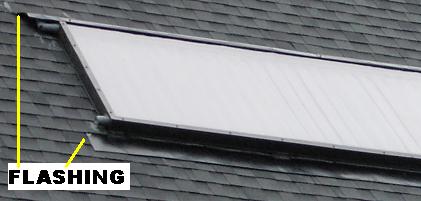
- Do proposals, appraisals and audits treat your house as a whole energy system? Be careful of
discussions that only look at
isolated areas that ignores the interactions of (for example) the fact
that cellular shades can make the house much more comfortable with a
lower heater or air conditioning consumption?
Appendix of
concepts behind what we do at Commonwealth Solar.
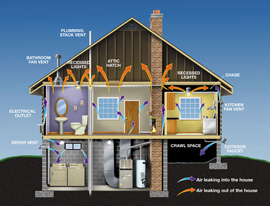
"Five Ways your Home Loses Heat"
Heat is lost to infiltration and air loss by over 3 times the amount it
is lost due to ceilings. These categories generally stack up this way
in terms of % heat loss in a home:
- Infiltration / Air Leakage: 35%
- Windows & Doors: 18%-20%
- Floors & Below Grade Space: 15%-18%
- Walls: 12%-14%
- Ceiling/attic energy lost to conduction because of lack of
insulation : 10%
(note: this last category of "ceilings" does not
include leaks through
microscopic cracks in the plaster, lifted drywall tape, moisture
damaged disintegration, holes for light fixtures, leaks through
penetrations for wires etc.)
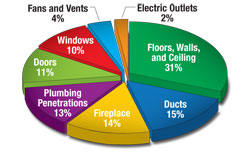
That is, put another way, insulation only insulates when air does not move through it.
Consider this example here of the green metal siding that obviously not
only did not prevent air flow, it did not stop flying insects such as
wasps from building their nests in the fiberglass "insulation" !
This insulation provided almost no benefit. Air filters for engines are
sometimes made of fiberglass. Fiberglass provides no air barrier of its
own.
Remember to compare these
general percentages with the cost for each repair and keep in mind that
blown cellulose
insulation both
insulates and reduces air
leakage.
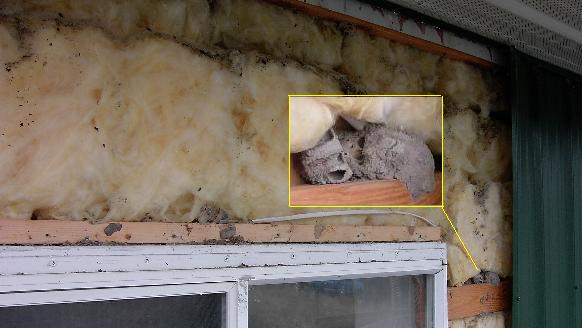
Insulation only works if there
is an effective air barrier.
An energy Audit is a detailed analysis of the hidden energy losses that
can increase your monthly cost of living by as much or more than a car
payment ! So ONE energy audit can save you many times the cost of a new
car! Even more importantly, those air leaks sometimes exacerbate
allergies to mold, vermin and dust as well as make you unecessarily
uncomfortable.
An independent auditor is the best first
investment during
planning for building upgrades because
that auditor
works for YOU and not for a commission on a bigger heat pump or more
expensive windows etc.
Some tips
on getting started with your own lifestyle and building shell "tuneup"
(audit).
Energy Star listing of "Common Problems" (most of which will be
qualified and quantified by a thorough energy audit.
Energy
Star on Audits
Dominion
Home Energy Calculator
How
much pollution does your energy consumption generate?
(note: to find how much pollution
an alternative energy source would save, just plug in the
estimated kWhrs of energy replaced by your alternative energy source
instead)
Also this includes the power line losses (estimated for your location!)
Home Energy Saver - Do It Yourself
audit guide
"Consumers don't want to buy electricity or
fuel.
They want warm showers and cold beer !"
— Amory and L. Hunter Lovins, Rocky Mountain Institute
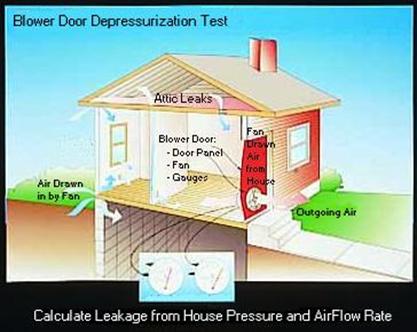
Blower Door
Uses calibrated fans and meters to measure how MUCH your building leaks
air. This give you the chance to see exactly how leaky or well sealed a
house is. Then after work is done, can see how much the efficiency has
been
improved.
One caveat to remember is that this simulates a very windy day. There
are some instances where a house can be leaky but if the leaks are
protected from the wind, it will still hold heat. But a Blower Door is
a great place to start with quantifying the effectiveness of your house
for holding heat and AC in.
Any audits you get on your building should include the Cubic Feet per
Minute and the calculated Air Exchange Rate that comes from using a
Blower Door properly.
Did the audit include the CFM and air exchange rate (number of
exchanges per hour.) ?
BTU
British Thermal Units. A unit of heat energy. To really compare energy
options, it helps to have a standard measure. Generally everything is converted to BTU's or
Joules of energy for comparison of options. Keep this in mind if
someone says "years ago I only paid $x to heat my house. Ahh, yes, but
what was the price per BTU ?
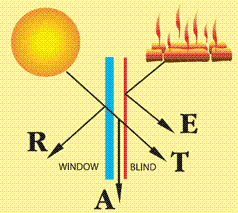
Cellular Shades
Cell shades are like adding a styrofoam panel to your window ...
in-effect superinsulating
your windows. They can also come with a track to block air from
flowing around the shades.
BUT ITS BEAUTIFUL AND RETRACTABLE!
[Click
here for a demonstration]
Cellular shades are especially helpful on the north side of a house
where you do not get any solar gain in the winter and thus want to keep
your heat in, but cellular shades can also help control excess heating
from the Summer Sun and keep your AC inside and the Summer Heat out!
Commonwealth Solar can install cellular
shades for maximum
cost-effective window insulation.
Drain Back vs Glycol Loop
There are essentially two most common solar thermal options for Central
Virginia.
Central Virginia has a freezing climate so any water left up in the
panels at night in the Winter or even Spring or Fall will likely freeze
and damage the pipes.
So option one is to have a sealed and pressurized loop like in your car
that uses an antifreeze solution (typical ethelyne glycol or "food
grade" Propylyne Glycol) that is filled all the time.
You should not drink antifreeze so a heat exchanger is absolutely
required.
Option two is a "Drain Back" (not to
be confused with "Drain
Down") system.
As the name implies, as the sun and/or temperature in the panels goes
down, the pumps stop and the water drains down into a holding tank that
is safely within the protected shell of the building.
The pumps also stop when the tank has reached the high temperature
cutoff point. The water in the panels drain back so that stagnation
damage is far less likely.
Commonwealth Solar's drainback system has been tested by the state of
Virginia* to collect and store more heat per square foot of collector
than most systems and is not pressurized and so has less potential
failure points than loop systems.
*John Randolph, Bob Schubert, Saifur Rahman, Yonael Tekiu, Virginia State Agency Solar System
Monitoring and Evaluation: Final Technical Report , Virginia
Polytechnic Institute and State University Blacksburg, Virginia
prepared for Virginia Department of Mines, Minerals and Energy,
Richmond, Virginia. May 1995
Ductwork
Heating and Cooling Ductwork is a MAJOR potential loss point for
heating and air conditioning!
- Air leakage through gaps in ducts. The heat is lost with
the air moving (convection).
- Air leakage through (convection) interface of duct to
wall/floor/ceiling
(registers)
- Conduction of Heat
through walls of ducts
Air leaks are the leading loss point for heating and
air conditioning.
The first goal of any efficiency and conservation
effort must include checking the ductwork for leaks.
Burying the
ductwork where possible under cellulose insulation will help
tremendously with both causes (conduction and convection) of heat loss
from ductwork.
We have even seen very "affordable" installed ductwork that was LEFT
WIDE OPEN, typically at the end of a house. We usually find those when
the occupants complain that an end room seems to get little or no air
flow from
the registers.
But where the ducts are in the attic or even (horrors!) out in the
outside air ... then proper testing, sealing and then insulating those
ducts is vital.
If the house seems to be
cheaper to
heat with electric space heaters, this is a very important piece of
evidence that your ductwork is hugely wasteful.
Two studies showed that ducted
homes had 70 percent more air leakage and used 17 to 22 percent more
energy for space heating.
- Consider that the square footage of exposed air is often
just as large in the ductwork as the entire ceiling of the building!
The duct has four sides and travels the length and width of most
buildings. In spite of this huge square footage of your conditioned air
to the attic and/or outside air, most ducts have no insulation or only
R3 for half an inch!
So putting ductwork in the attic is like adding another
whole attic of heat loss in the winter or heat load in the
summer.
So a duct exposed to the heat and cold of an attic with no insulation
or only R3 of an inch or fraction of an inch makes heating or cooling
a house with ducts in the attic like heating and cooling an
entire additional building. Is your wallet up to that?
- The solution is to either place the ductwork in the conditioned space (not in the
attic) if you are installing a new system from scratch for an upgrade
of a historic house or building a new building.
- If the ductwork already exists in the attic, then seal and
insulate as much as absolutely possible. Check that ductwork
periodically because often some of the sealing will fail over time.
- Also pay attention to how well sealed the registers are to
the wallboards, ceilings and floors especially because a leaky return register can draw in air
from the inside of the wall or even outdoors which might include mold,
illness causing
irritants like fiberglass fibers, and vacuum air from the
basement or crawlspace through the inside of the wall where holes
in the base allow air to come up from below.
Oikos noted that one study showed that "by repairing
43 percent of the duct leaks, they cut infiltration by 63 percent."
and that "heat
loss from the average ducted air distribution system reduces the
overall system efficiency by 30 percent."
An independent auditor is the best investment because that auditor
works for YOU and not for a commission on a bigger heat pump or more
expensive windows etc.
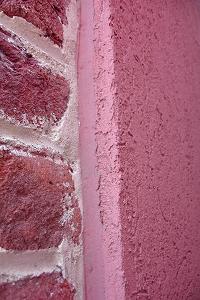
Exterior Insulation
Usually a brick or concrete foundation and/or walls are insulated
inside. However when possible, its actually better to insulate on the
OUTSIDE.
Exterior Insulation usually with foam panels provides a wonderful
opportunity to use the "thermal mass" of your building to your
advantage. Thermal mass is any heavy mass (like the thick walls of
older municipal buildings, or a cave, for example) that change in
temperature very slowly. Thus as you go into Summer, the cooler
condition of the thick walls decreases your need for Air Conditioning.
And then as you enter Winter, the left over heat from the Summer
decreases the rate at which your house cools off.
Insulating the outside of a thermal mass, that is, a thick brick or
concrete wall and/or foundation now means that effect is amplified
because you have insulated your walls from the extreme heat of early
Summer and the extreme cold of early Winter. As you run your Air
Conditioning or Heating, it is now heating a wall that averages the outside temperature
as well as absorbing as a kind of "thermal battery" your efforts to
cool or heat your house to the temperature you want.
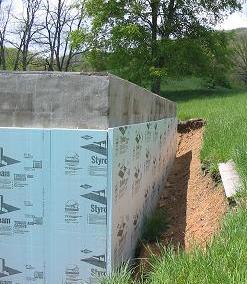
An added benefit is that in some cases there are many microscopic holes
in the mortar that allow diffused air to be drawn through the brickwork!
So instead of "pointing" the joints in brick, another option that gives
you energy efficiency benefit is to put on exterior insulation.
(For example, in one blower door test, we found a steady blast of air
coming down a chimney. This was in spite of the fact that the top of
the chimney was capped solidly. It turns out the mortar had failed to
some degree, it needed pointing, and so the air was coming into the
house through the mortar!)
Financing
Financing your investment into being more healty, wealthy and wise with
a more efficient building and then
alternative energy production is a HUGE topic. This appendix entry only
skims the surface.
The short version is that wealthy and healthy people combine
- Luck (hey,
you're HERE aren't you?) with
- preparation
multiplied by
- perspiration
to
spend less money over time to
live
than people who have to scramble from
month to month.
Put another way:
If a poor person can only afford
the leaky $10 boots,
and
they last a year
(and comes with wet feet from leaks),
A wealthy person can buy the
$50 boots that last 10 years.
The poor person will have spent
twice as
much as the wealthy person at $100
and
still have wet feet!
So now that we've decided we'd rather have dry warm feet at half the
price, consider how
to pay for toasty toes:
- Theres Rate of Return
for this
investment to
consider.
- There are Solar Renewable
Energy Certificates (SRECs) that can actually pay YOU
money ! (see below)
- There are various tax credits and other benefits at the DSIR database.
- There are EEMs, "Energy
Efficient Mortgages"
- Federal Conservation Tax Credits.
-
-
On Tuesday, February 21, 2006 the Treasury
Department and the Internal
Revenue Service (IRS) released the long-awaited "Guidance Notices" on
claiming tax incentives for energy efficiency improvements to existing
homes, new energy efficient home construction and new energy efficient
manufactured housing.
-
Federal home energy efficiency improvement tax
breaks for home upgrades. For more information, click here.
- The risk that your house or building will burn down without
insurance is a lot less than a stock market meltdown. What is
that Peace Of Mind worth that you might be able to afford toasty toes
in your retirement even with less money than you originally planned on.
- And future inflation
becomes your friend with efficiency improvements!
- The sun will
not burn out for many generations and is free.
- The heat coming from the
earth (geothermal) is free.
- This solar and geothermal heat you manage with
insulation, airsealing, properly treated window
efficiencies and other building shell efficiencies will cost you less
and less as a proportion of your other expenses and income over time
with inflation.
What is it worth to have more freedom from Energy
Insecurity and all the trouble that addiction to energy has gotten us
into?
More
from RESNET on Home Energy Mortgages
An example webpage of an
Energy Efficient Mortgage (EEM) at myEnergyLoan *
*Please note that Commonwealth Solar does not recommend any particular
loan products. This is only an example.
Flashing
See "Roof Flashing"
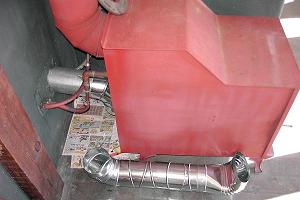
Fresh Air Vent
Any device that consumes oxygen while burning a fuel (combustion), such
as a wood stove or the gas water heater will
suck conditioned air out of your living space and flush that
conditioned air out the chimney or exhaust.
That is, unless you give your combustion device a "fresh air vent".
That fresh air vent gives your combustion devices (gas, oil or wood
fired boilers, gas or oil hot water heaters, fireplaces) a place to get
fresh air besides your air.
Another benefit is that your house doesn't dry so dramatically and your
skin thus is not as dried out and not as likely to get nosebleeds from
overly dry air. As the combustion device sucks up air for the burning
of the fuel, it tpumps that moisture laden air out its exhaust or
smokestack. This creates a vacuum in the house so you feel any leaks
all the more dramatically . The cold air outside is drier than the warm
inside air and so the overall humidity in your house drops thus drying
out your skin and nose. Flaking breaking skin and nosebleeds often
result.
A fresh air vent can also make a dramatic difference to your lung's
health.
There are various events and conditions (such as "stack effect" caused
by air leaks into the attic) that can cause a lower air pressure in
your basement than the smokestack of your combustion device ... and
pulls the polluted exhaust into your living space ! The fresh air vent
prevents that "backdrafting" that can sometimes kill you with pollution.
In this picture, you can see a "hydrostove" with a fresh air vent
installation. In this picture the vent installation is not complete so
you can see part of the vent ductwork laying on the floor for you to
see. Even without the stove running, you could literally see
the dust on the floor blow away from the open end from the air coming
in from outside! The hydrostove helps make the wood burning more
effective as well since excess heat at any one time is stored by the
water tank. The hydrostove makes up for hot water not heated by the
occasional multiple-day overcast event that reduced the solar panel
effectiveness.
Heat pump hot water heaters
Heat pump hot water heaters make more sense than solar panels if there is very little hot water used, (less
than 60 gallons a day used) such as
an administrative office building one or two adults in a household with
no jacuzzi.
For an analysis of heat pump hot water heaters, see this Washington
State University study.
As a bonus, the heat pump hot water heater can:
- Dehumidify your space, especially useful in crawl spaces
and basements, kitchens and bathrooms.
- Add air conditioning to an adjacent space, like a kitchen
or bathroom
(vent the Hot Pump Hot Water Heater to that space in the warmer months,
but switch to ducting to the outside in the Winter)
For more information about a system we commonly use, see: http://www.aers.com/etech_residential_water_heating.html
Heat Transfer
Understanding some basics of heat transfer will help you save money
and energy consumption.
- Heat moves from a hot place to a cold place
- Heat moves in proportion to the DIFFERENCE in temperature.
So it costs more to heat a house on a 20 degree day because the heat
moves more quickly out of your house.
- Heat moves in three different ways that must be addressed
differently
- ConVECTion (with moving air) This is the most common way
you lose heat (Ex: Hot air
coming out of the duct leaks). Also a way to get hot air coming in
during the summer.
- ConDUCTtion (ex: The hot frying pan to your food)
- Radiant (ex: The Sun shining on you and your house)
Any plan for efficiency, energy conservation and targeted alternative
power must take all three forms
of heat transfer into account.
Homeowner Association Restrictions On
Solar (Deed
Restrictions)
Suburban developer created deed restrictions
against solar panels and certain efficiency improvements can deny
people
the chance to earn SRECS money for their systems and destroys people's
income and freedom from energy independence.
Most Homeowner Associations (HA) are actually formed by the developer
and
not the homeowners. Some HA's are so restrictive as to consider flags,
growing food or clothes lines as "eyesores"!! If you are unlucky enough
to be stuck with such a HOA, there is hope.
Luckily satellite dishes
are now exempt from those restrictions and so
there is hope for sanity yet.
Insulation
The theory behind insulation is to slow heat
transfer. This works regardless of the direction of the heat flow.
Heat moves from hot to cold places in proportion to the difference in
temperature. So in summer, your air conditioned house loses heat
outward to the hot outside. Your house will get hot faster when its
hotter outside. In the Winter, reverse the process. Insulation will
work the same in either case.
Insulation slows heat transfer by impeding the three different way that
heat moves (see heat transfer)
The most effective insulation is a vacuum. That is why we used to have
"vaccuum thermos" containers before we came up with advanced closed
cell foam that could be blown into shapes.
In a vaccuum, the heat cannot move by either convection or conduction.
The next most effective insulation is air. STILL air. If the air moves
either through an area, then it is transferring the heat by convection,
like in your oven. Air gaps that are too large can have "convection
currents" that go in a loop to carry the heat from a cooler window pane
to a hotter one. Or inside a wall gap. If there is a leak, then the air
just carries the heat with it through the air gap. That is why leaks
are so important to heat loss control.
So the goal is if you can't have a vacuum, to keep the air STILL. That
is why double paned windows and foam and air barriers with fiberglass
work better than single pane windows or fiberglass with no air barrier.
Fiberglass is used on engine air filters. Fiberglass does not stop air
flow. So without an air barrier, fiberglass is nearly worthless, only
slowing the heat loss slightly.
Closed cell foam works by trapping cells of air. Open cell foam also
traps some air, but not as much. Styrofoam encapsulates tiny tiny air
bubbles in plastic.
Storm windows work by slowing or stopping air flow.
Cellular shades work by trapping a cell of air.
Exterior insulation works by trapping air outside stone and mortar so
the air inside can use the stone as a "thermal battery" and store heat.
Eventually entropy wins and everything ends up the same temperature.
Insulation only slows that process down.
Interior Storm Windows
Interior storm windows are very easily made of "clear" pine or other
more attractive wood and slips into the inside of the window to create
an air barrier for far less than a new replacement window. It also
allows you to keep the historic windows but stop the air loss.
Also interior storms can be constructed for rental historic office or
residences cheaply enough to save more than what was spent on the storm
windows. There are also more permanently attached magnetic interior
storm windows.
Interior storm windows stop the air leakage that accounts for MOST of
the lost heating or air conditioning. Then shade cloth in the summer
prevents too much radiant heat from the sun coming in. 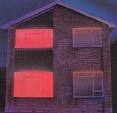
Cellular shades can insulate the windows from conducted heat lost in
both winter (nighttime) and the summer (daytime).
Generally interior storm windows are made on a wooden frame sized to
the window minus about 1/8th of an inch. Then weatherstripping is
applied to the outside after PolyOlefin ("heat shrink") film is wrapped
around that frame. That weatherstripping provides both the air seal and
the friction to keep the interior storm window in place.
Commonwealth Solar can manufacture
interior storm windows.
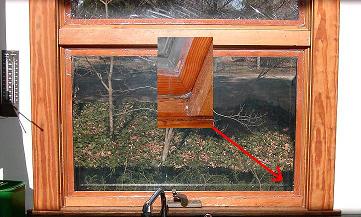

Lighting
Illumination makes up a huge part of any typical energy bill for a
building.
There are several issues that can be addressed to make lighting more
beautiful and efficient
- Incandescent lights are essentially heaters that also make
light since 90% of the energy goes into making heat. There are other
ways to illuminate your work and play space.
- The worst problem case are the recessed incandescent
lights or halogens that are each a potential fire hazard and "smoke
stack" that will pull heated or cooled air right out of your living
space!
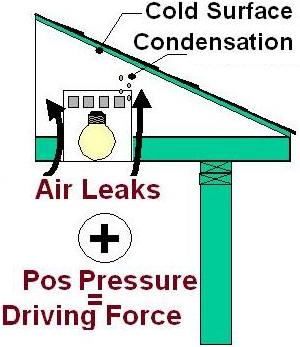
A professional energy auditor will pay a lot of attention to recessed
lighting.
Many times there is no insulation or sealing on the recessed lighting
containers and this becomes the equivalent of several wide-open windows!!!
- Fluorescent lights are now available in may colors of
light, not just "flickering blue".
- "Light Tubes" can bring in light from the sun through your
roof yet are air sealed and insulated unlike skylights.
- LED (Light Emitting Diode) lights are in rapid development
and can provide solar powered backup task lighting for your dark
corners or key places like bathroom,
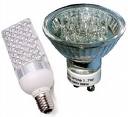 kitchen countertops etc. and can provide a lower cost
way to have emergency lighting backup than building a solar panel
system to run the entire house. kitchen countertops etc. and can provide a lower cost
way to have emergency lighting backup than building a solar panel
system to run the entire house.
Misconceptions that Misappropriate your
Money
There are many common misconceptions and occasionally
misinformation
that will waste your money and give you very little to no comfort
increase for the dollar.
Once you understand some basics, you can see where a trained energy
detective auditor can make a huge difference for much less investment.
Here's just a selection of four examples:
Example 1: Fiberglass
insulation. Air filters are often made of
fiberglass. You can often SEE where a leak of air has passed THROUGH
the fiberglass insulation by the dirt that it has filtered out of the
passing air.
Fiberglass insulation only
works when there is no air flow or air pressure. Typically an
air barrier of some kind ensures no airflow so that the insulation can
work.
Dusty dirty fiberglass tells you that either
no air
barrier was installed,
or was badly
installed,
or has failed.
Using blown celluloses insulation instead of rolls of ineffective
fiberglass does a much better job of filling in gaps
and stopping air flow.
Commonwealth Solar provides the service
of
blowing cellulose insulation and simultaneously sealing your
attic and walls after a proper audit
For more information on controlling air flow
with insulation and vapor barriers see Building Science.com.

Example 2: Misconception:
Radiators are
inefficient. A radiator will lose the most
heat to whatever is closest and coldest. Heat goes from a hot place to
a cold place.
So what is the coldest place that is closest to your radiators?
The wall of course!
So by placing pennies worth
of reflective foam
insulation behind your radiator you dramatically lessen the lost heat
to that cold exterior wall!
Example 3: Solar Attic Fans. An
attic stays hot long after the sun goes
down. Also the purpose of ventilation is to remove moisture (if there
is any) as well. A solar activated fan typically does NOT have any
moisture sensor.
Far better to
- install a ridge vent and/or
- bury your ductwork
in blown cellulose
insulation
and/or either
- get a reflective
roof such as TPO with insulation under the membrane or
- seal the roof
in something like the silver or white
coating that also has the benefit of protecting your roof tiles, metal
or membrane from the sun's UV and heat.
- This will also reduce the heat load on
whatever is inside your attic, such as your heat pump air-handler. The
less your air handler has to fight, the less you pay and the longer it
lasts.
Example 4: "Houses must breathe".
A house must stay dry. You do
the breathing. Properly handling the moisture is the key. A musty smell
and dripping windows are your hints that there is a problem. Building Performance
Institute literally wrote the DOE book on moisture management
health issues from mold.
[More
on energy wasted by
ductwork
in the attic and how you can save
that]
More On why a
Professional Energy Audit
should always be a part of
purchasing or upgrading a house.
There are many other
misconceptions for which there are tricks
of the trade.
Call
Commonwealth Solar to
have an energy detective find your energy thieves and help you spend
the money you already use for energy much more effectively!
Moisture
A house does not need to "breathe".
A house needs to stay DRY to prevent rotting, rusting and mold that
harms you and the house.
Moisture can come from uncovered earth beneath the house in the crawl
space or through untreated concrete in a basement or leaks from above
in the roof or walls or window frames or from plumbing or improperly
plumbed equipment such as the air conditioner handler.
Moisture is mostly carried on air currents. That's why kitchens and
bathrooms come with powered vents to remove excess moisture after
bathing and cooking.
So by stopping air flow
with proper air sealing and insulation to prevent condensation is the
most effective way to prevent transfer of moisture.
Moisture above 49% humidity can cause ubiquitous mold spores to grow
and damage wood and in some cases, people's lungs etc.
You can never "eliminate" mold. Mold is ubiquitous in nature and is
ever-present.
You can only control mold by
denying the spores access to moisture or organic materials that give a
great base to grow on.
One way to control mold during a building upgrade is to use "paperless sheetrock" that
uses
fiberglass matting instead of paper to contain the gypsum. While
plaster itself is not very friendly to mold, the wooden lathwork that
is typically used with plaster is VERY mold friendly.
For more detailed information on moisture and its control visit Building Science.com
Building Science literally wrote the Department of Energy books on
moisture control and "sick building syndrome".
Nega-Watts
Phase coined by Amory and Hunter Lovins of the Rocky Mountain Institute
in a book titled, Brittle Power:
Energy Strategy for National Security (pdf) in 1982 .
The idea is that for several reasons, a saved watt can be more
effective than another watt of produced energy. Some selected reasons
(not limited to) :
- Energy from a centralized huge remote coal,
nuclear or hydro power station is lost in the high voltage transmission
lines. If you have a more efficient device that used one less watt, its
actually the same as MORE than one watt of greater production needed
for the
less efficient device!
- Centralized systems are subject to brownouts when
consumption exceeds the systems ability to maintain voltage levels.
More efficient devices and buildings means less brownouts. Sometimes
brownouts lead to blackouts.
- More energy production leaves massive pollution behind.
Less pollution and destruction of nature means more of a legacy for
children to come.
- Since we have not yet learned how to harvest materials from
asteroids, the moon or other planets, we currently only have ONE planet
of materials. Its prudent to consider "Waste Not Want Not".
- If your systems are very efficient, they can often run off
batteries charged with solar power much more cost-effectively thus
giving you freedom and peace of mind as well as health, wealth and
wisdom (since now you have the time to reflect instead of rushing from
job to job frantically to pay for more production).
- DONT FORGET THE WASTE IN THE TRANSMISSION LINES And
if you are no longer beholden to
centralized power brokers, you are freer to be who you want to be.
Passive Solar
Passive solar are architectural features that do not require your
active participation in order to manage the energy from the sun as it
impacts your house.
For example, careful placement of windows can allow the sun to
heat your entire house even when there is snow on the ground!
While most passive solar features must be considered at the time of
design for the building or addition, there are some features that can
be retrofitted later.
For example, proper placement of appropriate trees can dramatically
increase solar gain in the winter while reducing the solar impact in
the summer.
Related to "Passive Solar" is the concept of "Passive
Survivability" ...
Passive
Survivability is an architectural concept that can make an "off
the grid" or emergency backup energy system much more affordable as
well as protect the occupants in emergencies.
One way to use Passive
Survivability to make an emergency system more affortdable:
- Make a list of the functions of your
building that make it useful.
- Then put power or resource requirements to each those
functions.
- Now rank the importance of those building functions like
"flat place to
sleep that isn't frozen", or "non frozen water pipes" or "medicines
like insulin kept cold in August".
- Now you create efficiencies that make those functions less
difficult to
sustain ...
- And finally plan for alternative energy systems to feed
only those
functions that are absolutely necessary during emergencies.
Another way an electrician might think of Passive Survivability when
wiring up Solar PhotoVoltaic panels to provide electrical power from
the sun is to talk in terms of a "Dedicated Loads Panel" that puts the
solar power into a selection
of the breakers for your house such as the
microwave, refrigerator and water pump, lighting just for the halls,
bathroom and kitchen.
This means you only power the vital functions making the system that
much more cost-effective.
Further Reading:
Pellet Stoves
Pellet stoves use wood waste that has been formed into pellets. Those
pellets are loaded into a hopper that is loaded by a computer
controlled wood stove at just the rate that results in the cleanest
burn for just the amount of heat needed at that moment. This is an
improvement over a regular wood stove that requires large-ish logs to
be cut up appropriately and then manually stuffed into the stove and
lit. The pellet stove can start up on a timer and avoids all the mess
of manually cut up wood and ashes as well as potential fire hazards
from manually cut and loaded wood if not handled carefully.
A wood burning stove can be an effective way to take the morning chill
off without running up your electric bill with the heat pump.
Heat pumps are less efficient for heating as the outdoor temperature
drops.
So since it is coldest in the morning just before the dawn, a pellet
stove on a timer or as auxiliary heat on a smart programmable
thermostat could kick on at 5am or so and warm the house at less cost
than a heat pump. Then the heat pump could come on in the afternoon
just before you get home to take that afternoon heat and sunlight and
"charge" the house with extra warmth (say up to 70 degrees) for your
return from work or school!
Farmers could support the electric grid by installing solar panels that
will actually be the most efficient in the cool of a clear morning, but
using pellet stoves to heat the bedroom and bathroom and sell that
excess energy for lighting and the shower.
Pellet stoves can use a renewable Virginia resource to heat with very
little electrical power (just for the fan and auger to move the
pellets.)
Pests
Pests like mice, rats, crickets, spiders etc. need moisture, food and
shelter to survive. Deny pests any or all and they leave your house or
die.
Sealing a house against air leaks closes off many routes to moisture,
food and shelter that pests need to survive.
One of the best ways to control cockroaches is to caulk the baseboards.
Termites like crickets must have ready access to lots of moisture. You
can tell a house has a moisture issue by how large a cloud of crickets
greets you in the crawl space or basement. Dont worry if a few hundred
bounce off you, they don't bite. Crickets are just an indicator of far
more insidiously damaging moisture problems.
Spiders like to eat flying insects so they set up their webs in the air
flow.
Spiders are a hint that air may be leaking in or out behind that spider
web.
And
while a mouse can fit through anything their heads fit through, if
you stop air molecules, its doubtful a mouse will get through either!
Don't forget that mice will climb up the outside of a house and come
down in through the attic! This is another reason that it is important
to seal penetration points into the attic as well as insulate.
Programmable Thermostats
A programmable thermostat can really help you be comfortable for less.
Programmable Thermostats help the most with heat pumps as opposed to
electric strip, oil or gas fired furnaces or boilers. However, a good
quality programmable thermostat can incorporate those features.
Since air leaks ensure that whatever air you heated or cooled 8 hours
ago has
long since leaked out and headed downwind of your house or up into the
clouds ... a
programmable thermostat cuts back the effort of your heat pump, furnace
or Air
Conditioner when you are not around.
Now, that said, there are some additional
factors to keep in mind!
- Thermal Mass. If your living space is right up against a
really thick wall or floor, it will take HOURS to heat up or cool that
down. In which case a nighttime set-back may make little difference.
This is obviously a site-specific problem. A thorough energy audit can
analyze this for you. Thick walls or other features can act as "Thermal
shock absorbers and slow the rise and fall of temperatures in your
building.
- If you have a heat pump,
make sure that the thermostat
locks out the auxiliary electric strip heat based upon the outside
temperature.
- Not all "programmable" thermostats have an intelligent
recovery feature that reduces overuse of the electric strip. The
intelligent recovery times the system to slowly (and more efficiently)
bring the temperature to the desired point at the programmed time
instead of just coming on full force at the time programmed into
thermostats that lack intelligent recovery.
- Heating more in the day or cooling more at night can
"Charge" your building's "thermal batteries" if :
- You are using an
air-source heat pump (this strategy does not work for electric strip, oil or
gas fired furnaces)
(Air Source heat
pumps are more efficiently heating
on Winter days
and running the AC at night in the Summer)
- There is a thermal mass to "store" that temperature. Like
an older brck house where the bricks are structural and a foot or more
thick. So this trick does not work as well on a house that has a wood
frame or
where the insulation isolates the bricks from your heating system.
If
your bricks are insulated on
the outside, then you get a
bonus! Your
system will now heat and cool against the average outside temperature instead
of whatever temperature it is today.
This
makes a kind of "thermal shock absorber" that your system can more
efficiently work with.
- In the summer, you can set some thermostats to activate on
humidity instead of temperatures. Since people sweat to cool off, the
humidity makes more difference to comfort than the actual temperature.
Also humidity is more important to mold and mildew control than
temperature. A humidistat option can save you a lot of money!
Make sure you install the programmable thermostat that fits the
configuration of your house! Thermostats for heat pumps are different
than thermostats for electric strip, oil or gas fired furnaces.
A professional energy audit can help here.
Energy
Star on Programmable Thermostats
Radiant Floor Heating (with solar
energy)
Thermal Solar panels are most efficient the lower the needed output
temperature.
Since a hot transfer coil in a forced-air heat ducted system needs at
least 130 degrees F to 180 degrees F ... trying to use solar thermal
panels for space heating is quite challenging.
Unless your space heating only needs 80 to 100 degrees F for the
working fluid to transfer heat!
A radiant floor heat system that uses 80 degree to 100 degree water in
tubes under your feet is easily
achieved with solar thermal panels!
According to This Old House,
for example, a radiant
system can be up to 30 percent more efficient than forced-air heating,
depending on how well insulated a house is.
Tool
Base on Radiant Floor Heating .
Commonwealth Solar offices have floor
heated by solar panels! Call to
come by and see it in action! The floor will often be over 60 degrees F
even when its below freezing outside.
Rate of Return on investment in
conservation and solar energy systems.
While all investments pose some degree of risk, the return on
a solar energy system is about as safe and predictable as,
well, the rising sun. Since the equipment is insured, this investment
is as risk free as it can get!
Also consider that if we are lucky, we all eventually come to a point
where we will live
on a fixed income. Wouldn't it be good if the COST OF OUR FUEL WAS ALSO
FIXED or even available?
Peak Oil will eventually mean that new easily accessible oil and
natural gas will no longer be easily pumped out of the ground and that
means that scarecity and high prices are guaranteed at some unknown
time in the future. Since China and India are dramatically increasing
their consumption of oil and natural gas, that is very likely sooner
than later!
Don't forget that coal and uranium use oil in the extraction and
transport processes.
And, after all,
even if the US Government fell, you house will probably still be
standing. And your building or house (unlike your 401k) was insured,
right?
So while solar fuel is free, the equipment to collect, store and
deliver it is not.
Conservation is very cost effective, though again, not free.
So what is the rate of return on investment on conservation and solar
energy verses other investments, most of which are taxed ?
The US Department of
Energy estimates that over 5.6 million homes have been weatherized,
saving 30.5 million MBtu
of energy each year. DOE estimates weatherization returns $2.69 for
each
dollar spent on the program, realized in energy and non-energy
benefits. Families whose homes are weatherized are expected to save
$358 on their first year's utility bills.[2]
Making
the upgrades for Energy Star certification costs just 1 to 3 percent
more but pays for itself immediately. According to Energy
Star, Energy Star House upgrades (such as windows with reduced air
leakage, properly sealed and insulated ductwork, insulated attics
etc.)add just $10 to $15 per month to your mortgage payment but save
you around $25 to $45 per month on your utility bills.
Many state LIHEAP
(Low Income Home Energy Assistance) programs
work side by side with US Weatherization Assistance Program (WAP) to
provide both immediate and long term solutions to energy poverty.
Other Examples:
Commonwealth Solar Example:
If a $6000 solar thermal system was installed for a 4 person household:
Solar Thermal can typically reduce hot water electric (or gas) heating
between 75% and 80%.
A typical household will use 20 gallons per person with a 70 degree
rise in the hot water tank,
according to ASHREA (American Society of Heating, Refrigerating and
Air-Conditioning Engineers) figures used for standards to plan by for
Architects,
8.33 btu/gallon
20 gallons per day in a 4 person household is 80 gallons a day.
70 degrees increse (from typical 50 degree cold water to 120 degree
storage temp)
That is 46,648 btu / day for that household.
3413 btu/Kilowatt Hour
12 cents per KwHr (divide your electric bill including everything for
what you REALLY pay!) Typically as of March 2009, most people find that
by dividing their monthly total payment by the number of kilowatt hours
used for that period, that they pay about 12 cents per KwHr.
----
13.6 KwHrs is $1.60 per day.
$584/ year for a regular electric resistive strip hot water heater.
And a typical two panel system for a family of four saves 80% off the
resistive tank so that SAVES $467.20
So now apply that SIMPLIFIED Rate of Return formula:
$467.20 / $6000 * 100 = 7.786% Investment Rate of Return
NOT including fuel surcharge increases !
(energy inflation)
Keep in mind that China and India
are dramatically increasing their energy usage ...
NOT including Tax Credits
NOT including SRECS (sends YOU money !)
Those last three items are moving targets and are hard to impossible to
calculate!
So consider that almost 8% as GURANTEED MINIMUM by quite a long shot!
And its insured by your homeowner insurance. Was your 401K insured?
The system can last 30 years easily so ... what's
that investment worth after 30 years?
That investment is the equivalent in $63,309 after 30
years when you have to rehab the system or install a new one. Sometimes
they last longer! Commonwealth Solar has been installing systems since
1975 and many are still in operation!
ALSO ... that's $63,309 that was NOT TAXED!
That's an additional $63,309 that was not taxed that you can invest for
retirement, use to go back to college, send your kids to college ...
start a business.
The payments for an Energy Efficient Mortgage at some 7% or sometimes
lower is way less
than the savings from the energy efficiency investment. And then you
pay it off and still keep the savings!
Speaking of keeping the savings - small savings can really get you out
from under that mortgage a lot earlier! Freedom
From Debt Much Sooner! In this example, if you saved $43/mo you
could pay off your mortgage three years earlier.
And finally, what is the rate of return on safely reducing your utility
bills many decades into the future when your income may be less than it
is now? What is the investment value of Peace Of Mind and Freedom to
live on less when you are older and living on a fixed income that may
not be as high as you originally planned?
[Sample
Analysis for example]
Resistive Strip Heat Sources
THE most wasteful way to heat anything with electricity is a strip of
wire.
Its referred to as a "resistive strip" though often it is in a coil
form.
In most heat pumps it is often called "auxiliary" heat or "emergency"
heat. It is often kicked on when the thermostat is run up more than 2
degrees from the current temperature. So be careful what kind of
thermostat you use and how it operates that resistive strip. Some heat
pumps use gas or hot water as the backup in which case this does not
apply.
The exception is when you need
heat in short blasts for little capitol
envestment and then save a lot of energy because the rest of the space
is less or not
heated.
An example would be a heater pad for your dog or feet where you
sit so the dog or feet are heated directly
and the rest of the house is left at 62 degrees. Another example is a
radiant heater in a bathroom. You only heat your body directly as you
come out of the shower with a focused parabolic shaped heater with the
glowing strip in the center. That way you leave the air temperatures
low during the other 23 hours and only heat your body as you exit the
shower. Don't forget to put those on a temperature sensor (so a warm
sunny day cuts off the foot warmer or dogwarmer) or timer or have the
memory of an elephant.
Speaking of hot water, the most common place to find a resistive strip
is in an electric hot water heater.
This is why anything you can do to reduce that heat use will save you
relatively large amounts of money.
Insulate the pipes coming out of the
tank (don't forget the emergency overpressure valve! Leave a
little
gap for the water to escape in emergency from that valve)
This is why thermal solar hot water is often a very cost effective
investment
and why for smaller households that use little hot water, a heat pump water heater is
cost-effective. You also get a bonus of dehumidification and cooling of
wherever that heat pump hot water heater is.
So watch out for any claims that so-and-so heater will save you money
... does it have any variation of a resistive strip? It might be more
efficient if you only heat
very small spaces for short
periods of time - like the bathroom or the doghouse.
- An incandescent lightbulb "heat lamp" is a resistant
strip. Even if they put it in a box!
- Electric baseboard heaters are resistant strips.
- Those portable oil filled radiators use resistant strips.
- The "Auxiliary" or "Emergency Heat" on some heat pumps are
resistant strips
- Infrared heaters usually use resistant strips
Radon
Radon is a radioactive gas that is emitted by Granite.
Proper sealing of a basement or crawl space should vent the radon.
Roof Coating
Silver or White coating can be painted on the roof shingles or membrane
to increase its reflection of the Infrared Light ("heat") from the sun reducing
peak cooling time costs by 10 to 15% (Energy Star) to 40% (Heat Island
Group) . Please note there is a recommended technique to applying
this material correctly.
When choosing a coating Pay
attention to the "emissivity" of the coating, shingles or
membrane.
ALSO silver rarely allows the black staining from the mold and mildew
that often grows on asphalt roof tiles. Thus it will likely actually
look better than the bare roofing shingles.
And ALSO the Silver or White reflective roof coating will protect the
roofing shingles and membranes so that you get much more lifespan out
of the roof
And finally, whatever is in the attic (such as the air handler for the
air-conditioning heat pump) will suffer less heat as well as the
ductwork thus reducing your air-conditioning bill!
One of the Commonwealth Solar installers, Christopher Maxwell, put a
TPO Energy Star reflective membrane on his 1906 downtown style brick
urban row house with a with passive vented attic. The summer
temperatures that occasionally hit 103 degrees F in the shade of a
roadside tree correlated with about a 95 degree attic at the same time.
The second floor was 92 and the first floor was 88 degrees F with no
air conditioning at that time! It was possible to use that space for
storage of most anything after applying the reflective roofing. Also
not so bad to work in when needed
Roof Flashing
Many solar panel installers do not give consideration to future roofing
repair and maintenance.
After 35 years of experience, we've had to go back and remove panels so
a roof can have its shingles or membrane replaced. Now we put flashing
on our panels and racks so that roofers can just replace the roof
membranes and shingles around the panels without disturbing them. The
panels protect the roof
underneath them.
The flashing is also angled with a downward slope so that snow and
leaves dont end up trapped on top and can fall away. This also helps
preserve the roof.
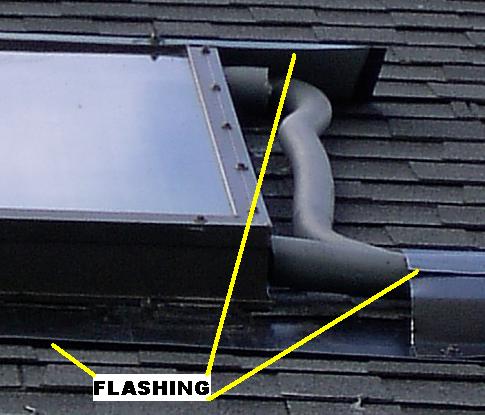
Here's another reason we flash the solar panels:
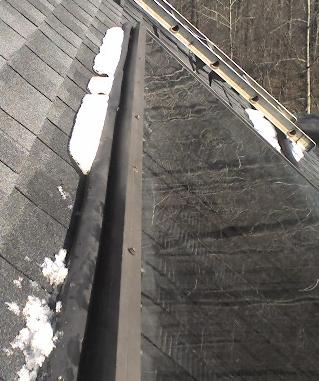 Snow and leaves should
not be allowed to get backed up behind the panel and rot the roof. This
photo shows the installation on the Davis house
before we added the flashing. The pipe is shown insulated all the
way, of course. The flashing is installed with a slight
positive slope so that leaves and snow don't back up behind a "dam" of
flashing either and flows off for cleanup. Snow and leaves should
not be allowed to get backed up behind the panel and rot the roof. This
photo shows the installation on the Davis house
before we added the flashing. The pipe is shown insulated all the
way, of course. The flashing is installed with a slight
positive slope so that leaves and snow don't back up behind a "dam" of
flashing either and flows off for cleanup.
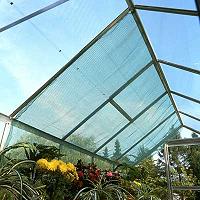
Shade Cloth
Shade Cloth is typically used by greenhouses to cheaply reduce
over-heating in
the summer.
It can work wonders for your house or building just as well !
It
is
- far more effective than architectural overhangs
- and reduces glare yet still can be seen through, unlike
shutters.
- reduces fading of furniture and rugs
- The heat is absorbed and reflected OUTside of your living
space thus stopping the excess heat before
it comes in your windows!
- Best of all, in the winter, it can be retracted or removed
to
let that solar gain in through
the window to
heat your house for free!
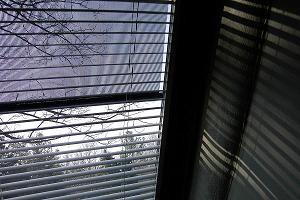
The sun coming in each of
your plain
windows can
bring in almost as much heat as an electric space heater per window!
So the shade cloth can really make life much calmer, cooler and easier
on your air-conditioner and thus your sweaty armpits and wallet.
Commonwealth
Solar can consult on and install all the various forms of window
insulation and heat control including shade
cloth.
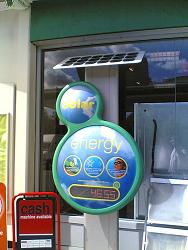
Shading
Shading is a very important issue for solar panels.
Solar panels are like many sun-loving flowering plants, they MUST have
DIRECT sun and the panels must FACE the sunlight in order to work well.
Solar panels are also most effective when tilted at an angle
(inclination) equal to the latitude on the Earth. In central Virginia
that is about 37 or 38 degrees inclined from the ground (horizon).
Notice for example that few plants besides moss grown on walls? That's
why.
Its amazing how many solar panels are placed or maintained without this
consideration.
Shading affects photovoltaic (electricity generating) panels much more
dramatically than solar thermal panels.
A solar thermal panel can have a small percentage of the panel shaded
by, say, a large branch of a tree or corner of a chimney.
But solar photovoltaic (PV, the electicity generating cells) must have
UNinturrupted solar along a "string" of panels.
An excellent example you are more likely to be experienced with are
Christmas lights whose bulbs have been wired in series so that one bulb
goes out and the entire string stops working.
Solar PV cells are the same way. When a panel is wired in series (as
they almost always are since each cell only produces half a volt and we
need from 48 to 120 or even 600 volts for a fully effective solar
installation) with two or more panels, shade that is completely
covering any ONE of those cells will inturrupt the electicity for the
whole string. Now sometimes you will see a pair or more strings that
are wired in parrallel. The shading only knocks out the one string that
is shaded, cutting the power of that system by one third (in a three
string system). But if that shade from a chimney or tree branch cuts
one cell in EACH string completely, then the whole system is out.
So when considering location for solar, remember that for PV, no single
one cell can be completely covered by shading or the whole panel and
string attached to that panel are now out.
Again, Solar Thermal is not as affected, but shading is
important to full performance there as well.
Watch your trees! They will grow. Check the species you have and what
their mature height and spread will be. Trees near your house are good
for cooling your house (use Gutter Helmets or similar to keep your rain
gutters clear) so you might consider putting your solar panels on an
"out building" like a tool shed or carport.
Solar Gain
The sun will generally transfer 200 btu/square foot through a clear
panel of glass.
A typical window thus transfers almost as much heat as a typical 1500
watt space
heaters!
Straight clear sun is over 300 btu. Clear glass is about 80% clear to
sunlight.
A typical window 3x5 feet so that's 15 square feet = 3000 btu
1 KW is 3400 btus space heater is typically 5000 btu
So you want to use that gain to heat your home in the winter, and get
rid of that heat in the summer with exterior shade
cloth
SRECs
Solar Renewable Energy Certificates (or
“Credits”) (SRECs) are
a commodity traded in the USA that represent 1 megawatt hour of energy
supplied
to the electrical grid using “Net Metering”.
You could get a
quarterly check for your installed solar generation system!
Sol Systems LLC, a commodity brokerage,
states that their
anticipated 5 year average SREC price is $350 on their Virginia Pricing
web
page. The value of the SREC is paid quarterly to the system owner after
subtracting the brokerage fee.
SRECs came into existence when states
implemented an RPS (Renewable Portfolio
Standards) in response to citizen demand for stable, sustainable power
that
polluted less.
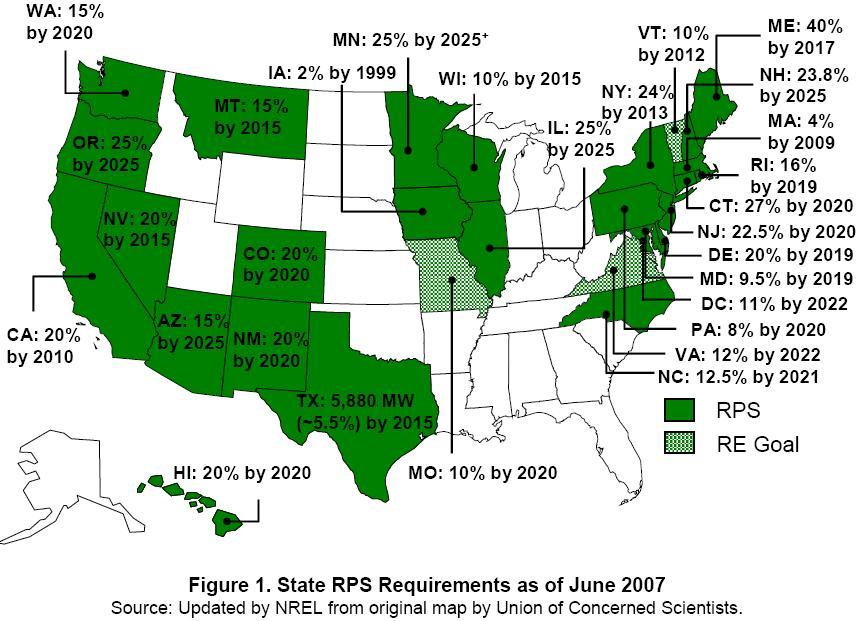
An RPS requires certain percentages (a
Portfolio) of a
region's power supplied comes from Renewable Energy sources. Virginia is a
part of the region called the
PJM power pool for DC,
MD,
PA
etc.
Many states near Virginia
connected to the PJM power pool have mandatory
RPSs that are enforced with a NonCompliance Fee (NCF) also known as an
Alternative
Compliance Payment (ACP). Some states such as Virginia have a voluntary
RPS (‘goal’).
A
large power producer such as Dominion or power
consumer may purchase SRECS so they can legitimately claim to have met
the
standard percentage or goal required of their power from solar energy
without
actually mounting a system on their building or land. Purchasing SRECs
for a
system on your building helps Dominion etc. avoid the controversy
associated
with running more power lines from centralized systems hundreds of
miles away.
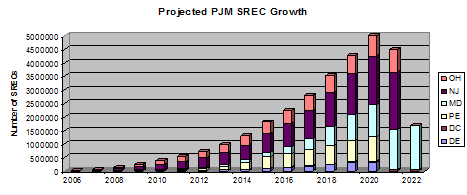
1000kWh = 1 REC.
Volatility in the price of traditional
energy sources due to
both greater demand by China
and India
as well as manipulation for economic or political gains by energy
players also
pushes the implementation of RPSs and the resulting SREC commodity
market. Fear
of future shortages is bolstered by the fact that even traditionally
conservative energy producers such as T. Boone Pickens now sees a
decline, known
as Peak Oil, in the efficiency of extraction for uranium, oil or coal.
In contrast, the sun is a stable source of
energy that
cannot be manipulated by large corporate or political forces.
SRECs are a commodity whose price depends on
supply and
demand. The value is provided by an NCF or ACP set by the government
body
demanding that the utility providing power to their citizens meet the
RPS. This
creates a modicum of a guranteed market for stable investment. On the
demand
side, often companies or government agencies buy SRECs also sometimes
known as
“Green Tags”.
Wikipedia
reports, “The Air Force is the
largest purchaser in the US
government in absolute terms, purchasing 899,142 MWH worth of RECs.
Among
colleges and universities, the University
of Pennsylvania in Philadelphia is
the largest purchaser of
RECs, buying 192,727 MWH of RECs from wind power. The corporate leader
is
Intel, with 1,302,040 MWH purchased in 2007, and the largest purchaser
among
retailers is Whole Foods, which purchased 509,104 MWH, or enough RECs
to offset
100% of its electricity needs.
Dominion sells an option to their
subscribers for renewably
produced energy at $2 per 133kwhrs.
The $2 blocks translates to $15 per REC.
Please
note the lack of an ‘S’, these are largely not
solar credits!
Dominion’s low price for voluntary RECs (mostly wind
power)
shows the value of mandatory
RECs that is predominant in most states at different
rates. The $2 rate may be a bit misleading since wind power is not
limitless. Wind power is limited by the availability of suitable
sites with enough steadily available wind and by opposition from
citizens and by the corrosion and
lightning damage
to marine wind turbines that leads to high maintenance costs.
Solar power on the other hand can be placed in any sunny space such as
your roof, as shading on a parking deck or the roof of a mall.
SREC commodity trading is complicated by
dozens of states
with different RPSs and NCFs or ACPs so finding the spot value of an
SREC can
be challenging. A further complication - states with voluntary RPS or
goals have
no enforced NCF or ACP. This complication explains the existence of
brokers of
SRECs such as Sol Systems LLC. Commonwealth Solar LLC has negotiated a
contract
with Sol Systems aiming for as realistic a balance to ensure working
systems as
possible at this time. For example, following consultation with
Commonwealth Solar LLC., Sol Systems has now added requirements to list
the equipment, model numbers and show that the system is not shaded as
a control against fraudulent system claims that may come about as the
shysters discover SRECs. This is one reason why Commonwealth Solar has
survived through the boom and bust cycles since 1976 - a real desire
for effective affordable solar energy in efficient buildings.
A further complication is that SOLAR
Renewable Energy
Certificates are made more valuable by different statutory provisions
in
different states. The method and amount differs by each state or even
city that
sets the Renewable Portfolio Standard (or Feed In Tariff) for power
sold to
their citizens.
Another factor in the price of SRECs beyond
a desire for
energy prices as stable as the sun is the realization that pollution
costs our
citizens and economy and resulting demand for reduction of that
pollution with
(among other tactics) RPSs that push for creation of energy that cost
us less
by polluting far less.
From Wikipedia:
(http://en.wikipedia.org/wiki/Photovoltaics )
‘Life-cycle
analyses show that the
energy intensity of typical solar photovoltaic technologies is rapidly
evolving. In 2000 the energy payback time was estimated as 8 to 11 years[80],
but more recent studies suggest that technological progress has reduced
this to
1.5 to 3.5 years for crystalline silicon PV systems [79].’
A third factor (of many) in the price of
SREC commodities is
recent talk of a national RPS.
If the possible national PPS includes a
reasonable mandatory
NCF or ACP, then when combined with the difficulty utilities have in
laying new
large power lines, there will likely be an explosion in the demand for distributed power production that can be
paid for with SRECs rather than centralized
big utility grade systems.
Centralized utility grade alternative power
out in the
middle of unpopulated areas must be backfed hundreds of miles into the
grid
with huge power lines. In December 2008 CSA.org reported that a
national RPS
may allow double counting of your SREC depending on how it’s written.
RPS and SRECs can also help combat fraud and
abuse of the
upcoming boom in solar energy. Fraudulent and incompetently installed
systems
in the last boom/bust cycle trashed the solar industry for a generation
harming
most and only helping a few shysters.
The recent efforts toward Smart Grids could
require that all
systems that receive any public benefit funds or tax breaks be measured
in
their outputs.
The smart grid could both measure and report
which systems
really worked and which worked better so the buyers, regulators,
installers and
maintainers of solar systems would have motivation as well as a
verification method
to ensure a properly functioning system. Also even the best intentioned
and
installed system can have breakdowns and a constant means of measuring
will
provide alert and diagnostic functions.
In the meantime, it is becoming more likely
that anyone
buying SRECs or brokering them will require some verification with a
production
meter attached to the solar system.
The web page on Virginia Pricing for SRECs
by Sol System LLC
shows a price for $350 per SREC as their anticipated 5 year average
price. The
broker pays quarterly minus their usual brokerage fee. This includes
the fact that Virginia
has a voluntary RPS. This may change (probably for the
better) with a
mandatory RPS in Virginia
or a national RPS.
Sources and
further reading:
Sharing Capitol Ideas website:
http://www.csg.org/pubs/Documents/TIA_RPS_screen.pdf
(please note that SOLAR Renewable Energy
Certificates are
worth more than other energy sourced certificates.)
Sol Systems position on Carbon Trading vs
Renewable
Portfolio Standards
The summary: Carbon Capture of coal is
vaporware and doesn’t
exist – solar has existed now for many decades!
http://www.solsystemscompany.com/blog/
Virginia
goals for Renewable Energy:
Dominion’s voluntary sale of “Green Power”
https://www.dominionenergy.com/virginia/renewable-energy-programs/green-power/green-power-faqs/
Some leading advocates of an RPS for Virginia:
CCan https://chesapeakeclimate.org/campaigns-overview/
Energy
And Security
Group http://www.energyandsecurity.com/areas-of-expertise.html
Energy
Justice
Network (critical of any RPS that allows dirty power to be counted) http://www.energyjustice.net/RenewablePortfolioStandards
Wikipedia for more detailed information:
Buyers of “Green Tags” or
RECs and SRECs: http://en.wikipedia.org/wiki/Renewable_Energy_Certificates
Comparing the different
methods of providing incentives for
solar energy: http://en.wikipedia.org/wiki/PV_financial_incentives
Feed In Tariffs :
Originally enacted by President Jimmy
Carter but made famous by the explosion
in solar energy systems installed in Europe resulting in 9% of Spain’s energy supplied by solar power,
5% in Germany and
20% of Denmarks
energy supplied by
windmills. http://en.wikipedia.org/wiki/Feed-in_Tariff
Later on we will have a spreadsheet showing
the rate of
return on investment you could expect based on certain assumptions with
SRECs
at different values. You then plug in whatever your information sources
cause
you to think they will be worth and inform your consideration
accordingly.
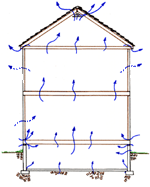
Stack Effect
How does the smoke get out of a chimney instead of coming into the
house? Because hot air rises and creates suction at the bottom pulling
the smoke up and out the top of the stack.
The same thing happens in any box ... including your house!
That is why you feel a draft at the bottom of a door more than the top.
And why the basement leaks are SO obvious when you find them. But you
can't seem to feel any leaks on the top floor ceilings.
That is also why the windows in the middle make less difference (in
still air) than air-sealing the basement, crawl space and attic.
That is also why air leaks and infiltration is the #1 cause of lost
cooling and heating.
And also why open fireplaces are a major source of lost heat ... and
why they often have glass doors in front of them.
One tip that this is rampant in your building is extra-dry air leading
to chalking skin and nosebleeds.
Combustion of air in your living space is then exhausted along with the
moisture and the cold air coming in is relatively dry thus dramatically
drying out your living space air and causing dry skin and your
nose.
TIP: CLOSE
THE CHIMNEY DAMPER When its not in use!
"According to the Department of Energy, a lit fireplace sucks about
24,000 cubic feet of furnace-heated air up your chimney each hour.
Bonus: It's replaced by cold air that comes in the opposite direction
through the same opening, causing your furnace to work extra hard to
keep your house toasty.
Crack a window in the room where the fireplace is located and then
close the door, so it doesn't suck too much warm air from the rest of
the house.
TIP: Provide a "Fresh Air Vent" for your
combustion devices (gas fired hot water heater, furnace, fireplace,
etc.)
Stagnation damage
"Stagnation
- when the pump ... does not run as intended during sunny conditions.
With a closed-loop glycol system the HTF (Heat Transfer Fluid) is then
left sitting in full sunshine in the solar collectors, without
circulating. The fluids are heated to a point where the buffers in the
e.g. an antifreeze solution are broken down, and the solution can
become acidic. The pressure can build up so much that the pressure
valve will open. This would safeguard the integrity of the collectors
and the whole system. The antifreeze has to be changed after stagnation
conditions.",
page 203, Tom Lane, Solar
Hot Water Systems: Lessons Learned 1977 to Today, Energy
Conservation Services, 2004
Stagnation is most common when a system is put in that is either
inappropriately placed (on a building or use that does not use its full
capacity, especially in the
hottest summer months!) or has not been maintained and doesn't pump
appropriately.
Stagnation damaged systems can usually be repaired and placed back in
service,
but stagnation on a maintained system or recently installed system
indicates that either the designer was not informed of the actual usage
patterns that result after installation (misunderstandings or perhaps a
change in usage pattern post installation, say, the house was
foreclosed on) or was installed inappropriately perhaps for showboating
to say "look how green I am" when it was an inappropriate usage.
For example, an innapropriate use for an antifreeze thermal system
would be an office building with no significant hot water usage on,
say, a school administration building whose staff is on vacation in
August when the system needs to be used the most to reduce stagnation.
Recommendation in this example scenario of a school admin building
would be to :
- Convert from a glycol (antifreeze) loop to a "drain back"
system and/or
- move the panel(s) to the cafeteria or the swimming pool or
locker room shower area for summer school use.
- Another fix for
stagnation is to stand the panels up at an very high inclination of,
say, for example, 60 degrees from the horizon.This will also have the
effect of making them more effective in the Winter months when hot
water is all the more appreciated.
"Drain back" systems do not suffer damage from stagnation except under very rare circumstances because of
a "high limit switch" that senses when the hot water storage tank has
reached a high temperature limit of, say for example, 160 degrees F
when any further heating could be dangerous or damaging to systems. The
high limit switch turns off the system pumps and the water drains back
(hence the name "drain back system") into the holding tanks. The panels
are now empty except for air and stagnation is not a problem when
drained.
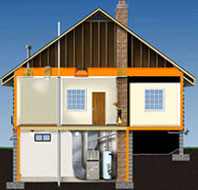
Thermal Envelope (Shell)
The thermal envelope is that border between your inside temperature and
the outside temperature.
Put another way, the thermal shell describes the part of the building
that separates your occupied
conditioned (heated or cooled) space from the outside. For example in
the attic, your "roof" comes in TWO parts. The outside part that keeps
out the water ... and the floor of the attic that separates the thermal
areas. The attic is vented to the outside and the insulation airseals
and insulates that from your top floor rooms.
Note that the thermal envelope is not always the same exact place as
the weather
(liquid) envelope.
In this picture, the orange parts are generally where you would place
insulation.
An exception is that, if you can, by placing the insulation on the outside of the thermal mass
(bricks) you can help make the house more efficient by using that
thermal mass to even out the temperature swings. Thus your heater and
Air Conditioner now works against your cliamates's AVERAGE temperature
instead of that day's temperature.
Here's
a link to a great example house ...

VaHERO
Virginia Home Energy Rating Organization was formed in the 1990s to
encourage independent intelligent energy audits of buildings.
The idea is that the cost of a house is intimately tied to what it
costs to heat and air condition that house. The payments for energy for
an inefficient building can easily equal a car payment! Unlike cars
whose many ten$ of thou$and$ of dollar$ are typically paid off in 5
year$ ... those high energy bill$ will continue to increase for many
many decade$ !
Consider asking your elected representatives to bring back some
variation on VaHERO or other Home Energy Rating System (HERS program)
that ties the appraisal of a house during sale to an energy rating.
There are some pilot programs that may bring us back to a HERS program
such as the proposal to Pilot
Test a Home Performance with ENERGY STAR Contractor Partnership in
December 2008
Virginia
currently is NOT one of the states with a Home Performance with Energy
Star program.
[more on VaHERO and HERS at Virginia
Solar Energy Association]
RESNET
and their belief in HERS to make mortgages more affordable through
energy conservation.
Windows
Windows are often touted as a quick way to make your house more energy
efficient and comfortable.
But since air leaks are THE major way to
lose heated and air conditioned air ... ASK HOW WELL DO THOSE WINDOWS
SEAL OUT AIR FLOW ?
A good window will have FOUR ratings. The most often hidden or not
mentioned rating for a window is how well it seals against wind and air
leakage due to Stack Effect.
Bob
Vila recommends you select windows with
air leakage ratings of 0.3 cubic feet per minute or less.
[More On Window Ratings]
[More on Window Ratings]
If the window rating sticker fails to mention how much air it leaks,
its probably not a good investment.
Air
leakage - air leakage can occur through and around
windows, and can have a significant impact on energy use and
comfort.Air leakage at existing windows may be improved through
weatherstripping and caulking. New windows are often tested for their
air leakage through the window (between frame and sash). Better
windows have tested air leakage rates between 0.01 and 0.06 cfm/ft of
perimeter. Casement, awning, and hopper type windows tend to have lower
air leakage rates than double hung or slider types due to the
compression of the seal when latched closed.
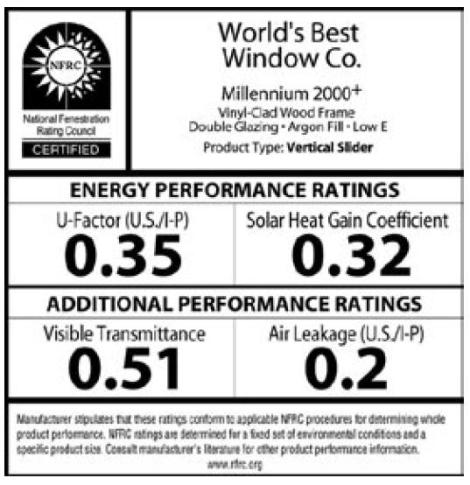
Another issue with windows is that the South facing windows should be
clear with NO "low-e" coating. This is so that you can accept the sun's
free warmth in the winter!
Go ahead and put low-e (emissivity) coating on the North, East
and West windows since you will not gain much heat from the sun on
those windows anyway.
Then properly manage the heat through your windows with :
Shade Cloth on the outside in the
summer to bounce back the sun in
August
Cell Shades to keep your heat in your
building on winter evenings.
Dont forget to
- Close
the cell shades in winter evenings and summer days.
- Open
the cell shades on Winter
Days.
Commonwealth Solar sells
and installs Comfortext
Cellular Shades
with automatic options.
Wind Pressure
Most of the time you are better off focusing more money and time on the
basement and attic. However if your building is exposed to a lot of
high wind conditions, it may make sense to spend extra attention on
exterior storm windows, interior storm windows, possible window
replacement (but check their air leakage rates
!!!!) and of course air sealing on the upwind and downwind sides of the
building.

Weatherization
tips:
According to the US Departement of Energy, "on average,
weatherization reduces heating bills by 32%."
- Seal
bypasses (cracks, gaps, holes), especially around doors, windows, light
fixtures and outlets as well as pipes
that penetrate the attic ceiling, pull-downs and attic stair openings,
light fixtures, and other areas with high potential for heat loss. Use
caulk, foam sealant, weather-stripping, window film, electrical
receptacle gaskets, door sweeps, and other items to reduce air
infiltration.
- Install insulation in walls,
floors, ceilings, and around ducts and pipes, and near the foundation
and sill.
- INSULATE THE PIPES AND VALVES coming out
of the hot water heater.(especially the
overpressure relief valve [leave an escape path for steam if it has to
blow!])
- and consider lowering the
temperature on your heater to 120 and
125 degrees.
Please NOTE: Wrapping extra insulation around a modern tank is not very
effective now with improvements in the last 20 years.
Additionally
there are liability issues if a pilot type natural gas heater has its
ventilation
blocked by the blanket and/or the anti scalding warning sticker is
covered. However, the "little radiators" in the form of the attached
pipes and overpressure relief valve have not had the same visibility as
an issue and are thus often overlooked.
- Add a shutoff valve to your
low-flow shower head so you turn off the water during soaping up. Shut
off the water at your sink except when you need water for rinsing.
- You can also get a
foot-pedal to shut off the water to a sink so that a press of the foot
gives you a blast of water just when you need it.
- Seal
duct work by ensuring that all ductwork is sealed at joints and
intersections with duct sealer, silicone caulk, an/or foil-backed tape
(not duct tape)
- Change furnace filters every
month and have all heating and cooling equipment service by a
professional annually. Some filters are reusable and cleanable.
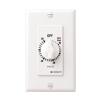
- Put your powered vent fans in
the shower and kitchen on countdown timers. Also kitchen vents can be
closed even more effectively by getting a sheet of magnetic material
and slapping that over the vent opening when you are not cooking. Even
though the fan is off, there is usually still some air flow naturally
through those vents unless they come with a fan-activated flap or valve
of some kind.
- Use
solar heating on sunny days. Open drapes/curtains on south-facing
windows when it is sunny outside. Note this works best withOUT
the "low-e" windows!
At night close the drapes to retain
the heat and keeps drapes closed on windows that receive no direct
sunlight.
For more weatherization tips and
information:
Recommended
Reading
- Brittle Power:
Energy Strategy for National Security (pdf)(1982), Amory B. Lovins
and
L. Hunter Lovins,
- prepared originally as a Pentagon study, and re-released
in 2001 following the September 11 attacks. The book argues that
domestic energy infrastructure is very vulnerable to disruption, by
accident or malice, often even more so than imported oil. According to
the authors, a resilient energy system is feasible, costs less, works
better, is favored in the market, but is rejected by U.S. policy.
- The
Home Energy Diet: How to save money by making your house Energy Smart,
Paul Scheckel
- Culture Change: Civil
Liberty, Peak Oil, and the End of Empire,Alexis Zeigler
- Virginia
Governor Tim Kaine's State Of The State speech 1/14/09 that features a
focus on energy security through independent conservation and production.
- "Our long-term planning should recognize that
conservation is just as important an energy source as new construction.
We should treat conservation investments at least as favorably as new
generation investments, ...
A University of California study recently concluded that the
conservation measures taken in that state had put millions of dollars
in savings back into the pockets of residents there, allowing them to
make private-sector spending decisions with more of their own money..."
- The
Virginia Energy Savers Handbook, (pdf) Dept of Mines Minerals and
Energy
- The
Hidden Costs of Energy,Michael Nicklas
- Advanced
Energy Knowledge Library, esp Arnie Katz columns
- Building Science.com.
- Joe literally wrote the Department of Energy book on
Moisture control
- Home Energy Saver calculator
- Especially useful to try different strategies on your
building!
- South
Face Institute on Air Sealing
- Oikos Green Building Source
- Energy
Star Home Upgrades
- Wrenches
List (if you really want to geek out on energy !)
- Energy
Star @ Home Tips
- PATHnet (Partnership
for Advancing Technology In Housing
- TOOLBASE
- US Department of Energy
- Oak Ridge National Laboratory Building Technologies Research and
Integration Center (BTRIC)
- 70
Energy Saving features of a UK-Energy Star exhibit
-
Links
www.mdv-seia.org
Maryland-DC-Virginia Solar Energy Industries Association (local)
www.seia.org
Solar Energy Industries Association (national)
www.homepower.com
The Hands-On Journal of Home-Made Power
http://lists.re-wrenches.org/pipermail/re-wrenches-re-wrenches.org/
Professionals discussion page (old
archives page)
http://lists.re-wrenches.org/pipermail/re-wrenches-re-wrenches.org/
Latest Wrenches List Archive
www.finehomebuilding.com
Fine Homebuilding Online
www.highlandcounty.org
Highland County Chamber Of Commerce - Monterey, Virginia
http://www.virginiasea.org/
Virginia Solar Energy Association
If you have
any
further questions, please email and ask so that we know what we need to
add to this appendix !
Contact via email
Note: Last Update 06/25/2021
CommonWealth Solar, LLC
12433 Autumn Sun Lane • Ashland VA,
23005
• (804) 216 5371
|








 kitchen countertops etc. and can provide a lower cost
way to have emergency lighting backup than building a solar panel
system to run the entire house.
kitchen countertops etc. and can provide a lower cost
way to have emergency lighting backup than building a solar panel
system to run the entire house.





